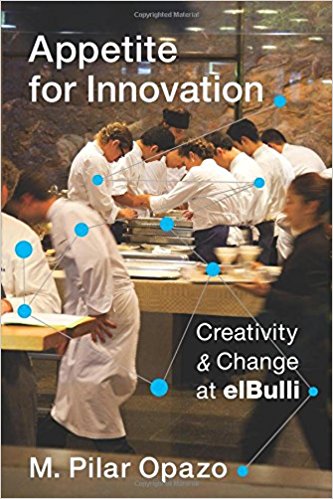What Can a Restaurant Teach Us About Innovation?
4 Min Read By Pilar Opazo
When Chef Ferran Adrià shuttered his famed elBulli restaurant in 2011, foodie circles were stunned. elBulli was at the peak of its fame: it had three Michelin stars and a waiting list of two million diners. Adrià—widely considered one of the most imaginative culinary minds of the world—operated in an elite class of chefs. He kept his restaurant open just six months a year and served one meal a day, never offering the same dish twice.
Rumors circulated that the closure was due to a family feud or money problems. But the truth was that Adrià was petrified of repeating himself. (“Can you imagine this pressure?” he told The New York Times. “You cannot.”)
In 2014 Adrià reopened elBulli not as a restaurant, but as a foundation dedicated to studying and understanding the nature of creativity. It’s a subject in which Adrià has passionate expertise. When he arrived at elBulli in the early 80s, it was a French restaurant. By the 1990s Adrià was head chef and elBulli was transformed as a test kitchen for gastronomic invention.
But while he became known for dreaming up dishes like Escoffier’s classic peach melba and smoke foam, Adrià was engaged in a far more ambitious project—achieving and sustaining a culture of innovation. He and his team established a set of best practices for organizational creativity and systematic invention. The result: processes and structures that are applicable not just to restaurants but other organizations as well. Here are some elements of elBulli’s, ahem, secret sauce:
They Built a Specialized Language of Creativity
Over the years, Adrià and his team devised new words, terms, and phrases to expand the language of gastronomy. Their new language captured and classified the elements of each new dish they created and helped codify the cutting-edge techniques and technologies they employed. Their new vocabulary was used as a toolkit that aimed to revolutionize cooking through every bite.
Establishing this Language had a Big Impact
first, it helped make the creative process more efficient. ElBulli’s kitchen, located in Catalonia, Spain, hosted chefs from all over the world and many spoke different languages. Giving them a lingua franca allowed them to reach a common understanding and coordinate their cooking in faster and smarter ways. Second, the creative language allowed Adrià and his team to stay laser-focused on their goal: bold breakthroughs. A precise language helped them identify and analyze the extent to which they were truly doing something new and different, versus merely reproducing past successes and refining on the margins.
They Were Open and Willing to Share
Everyone who worked in Adrià’s kitchen understood that experimenting with food and flavors was only a part of elBulli’s mission; documenting and sharing what they learned from that testing was its true purpose. Adrià and his team recognized that advancing the culinary movement required that they communicate with the wider community. (Later in elBulli’s history, Adrià founded a publishing house to disseminate recipes and information.) This level of transparency and openness allowed other chefs to not only learn from elBulli’s practices and processes, but also apply them in new and exciting ways. For instance, elBulli was the first restaurant to open a culinary lab that worked alongside its kitchen; today that is a standard practice among avant-garde chefs.
Adrià’s openness seems counterintuitive in a business environment in which trade secrets are considered a competitive advantage. But transparency worked to elBulli’s benefit. It cultivated a network of devoted followers—disciples if you will—who created a virtuous circle around the organization. This heightened the restaurant’s influence and helped it become a dominant force in the food industry.
They weren’t afraid of radical reinvention. If ever Chef Adrià felt that elBulli was getting tired or stale, he’d make a dramatic change. He’d reconfigure his cooking team; he’d swap summer ingredients for winter ones; or he’d recruit new apprentices from different parts of the world. Once he even built a new kitchen. Adrià knew that change is integral to maintaining an artistic edge. His desire to stay innovative was a driving reason he converted elBulli into a foundation. Today he and his team collaborate with top chefs, computer scientists, chemists, authors, philosophers, and designers to transform haute cuisine.
Reinvention at this scale is expensive, radical, and risky. But it is also necessary to inspire innovation at the organizational level and even worldwide. By constantly deconstructing the system that supported creativity, Adria was able to shift the rules of the game and, ultimately, to maintain a strategic position in the restaurant industry.
Other firms should take note. After all, innovation today is not just an advantage for organizations but a requirement.
Opazo’s book, Appetite for Innovation: Creativity and Change at elBulli, explores the many ways in which Adrià and his team pioneered new ingredients, flavor combinations, and cutting-edge culinary techniques in a quest to revolutionize haute cuisine. Part business analysis, part restaurant history, the book is a critical examination of how organizational creativity can be achieved and sustained over time.
Opazo’s book cites examples from other fields, including art, science, music, theatre, and literature to inform practices of innovation and creativity in multiple kinds of organizations and industries. Each chapter of her book opens with an iconic recipe created in elBulli’s kitchen.
Modern Restaurant Management (MRM) magazine is hosting a giveaway for a hard copy of Opazo’s Appetite for Innovation: Creativity and Change at elBulli. To learn more, click here.


